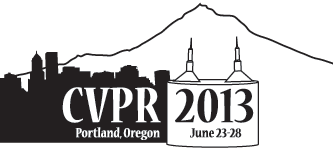-
Detection Evolution with Multi-order Contextual Co-occurrence
AbstractContext has been playing an increasingly important role to improve the object detection performance. In this paper we propose an effective representation, Multi-Order Contextual co-Occurrence (MOCO), to implicitly model the high level context using solely detection responses from a baseline object detector. The so-called (1 st -order) context feature is computed as a set of randomized binary comparisons on the response map of the baseline object detector. The statistics of the 1 st -order binary context features are further calculated to construct a high order co-occurrence descriptor. Combining the MOCO feature with the original image feature, we can evolve the baseline object detector to a stronger context aware detector. With the updated detector, we can continue the evolution till the contextual improvements saturate. Using the successful deformable-partmodel detector [13] as the baseline detector, we test the proposed MOCO evolution framework on the PASCAL VOC 2007 dataset [8] and Caltech pedestrian dataset [7]: The proposed MOCO detector outperforms all known state-ofthe-art approaches, contextually boosting deformable part models (ver.5) [13] by 3.3% in mean average precision on the PASCAL 2007 dataset. For the Caltech pedestrian dataset, our method further reduces the log-average miss rate from 48% to 46% and the miss rate at 1 FPPI from 2atfto m44%%compared with the best prior art [6].
Related Material
[pdf][bibtex]@InProceedings{Chen_2013_CVPR,
author = {Chen, Guang and Ding, Yuanyuan and Xiao, Jing and Han, Tony X.},
title = {Detection Evolution with Multi-order Contextual Co-occurrence},
booktitle = {Proceedings of the IEEE Conference on Computer Vision and Pattern Recognition (CVPR)},
month = {June},
year = {2013}
}
These CVPR 2013 papers are the Open Access versions, provided by the Computer Vision Foundation.
Except for the watermark, they are identical to the accepted versions; the final published version of the proceedings is available on IEEE Xplore.
Except for the watermark, they are identical to the accepted versions; the final published version of the proceedings is available on IEEE Xplore.
This material is presented to ensure timely dissemination of scholarly and technical work.
Copyright and all rights therein are retained by authors or by other copyright holders.
All persons copying this information are expected to adhere to the terms and constraints invoked by each author's copyright.

